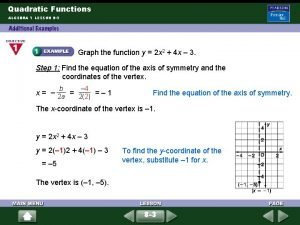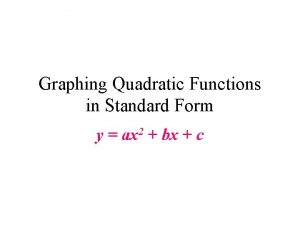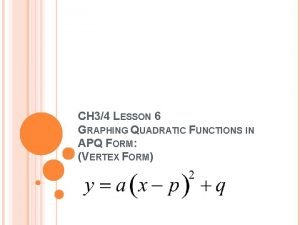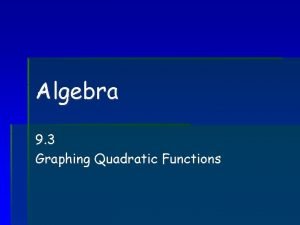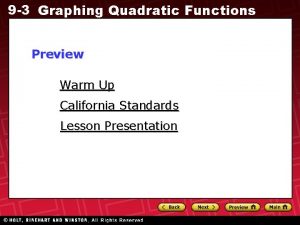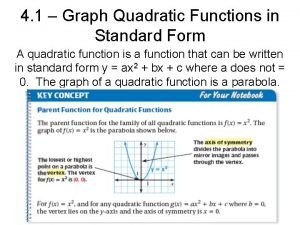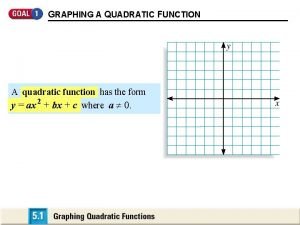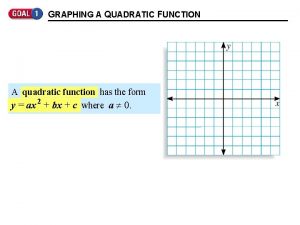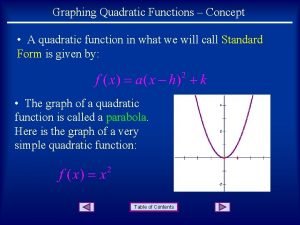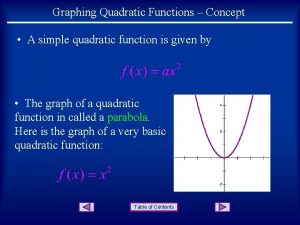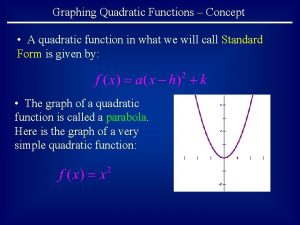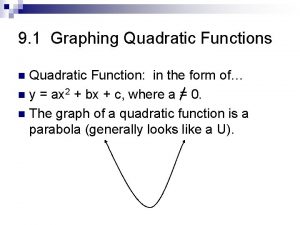GRAPHING QUADRATIC FUNCTIONS Dr Shildneck A QUADRATIC FUNCTION












- Slides: 12

GRAPHING QUADRATIC FUNCTIONS Dr. Shildneck

A QUADRATIC FUNCTION has the standard form y = ax 2+bx+c where a ≠ 0. The graph of a quadratic function is a U-shaped curve called a PARABOLA. The highest (or lowest) point on the graph is the point where the curve changes direction, and is called the VERTEX.

The graph of the most basic of a function is called the parent function. The most basic QUADRATIC FUNCTION is y = x 2. The vertex of y = x 2 is the origin (0, 0). The vertical line that cuts the graph in half, symmetrically, is called the Axis of Symmetry. (AOS) Note the patterns in the parent function…

BASIC CHARACTERISTICS OF A PARABOLA v If a > 0 the parabola will “open” up. v If a < 0 the parabola will “open” down. v If |a| < 1 the parabola will get wider than the parent function (rate is slower) v If |a| > 1 the parabola will get narrower than the parent function (rate is faster)

GRAPHING FROM STANDARD y = ax 2+bx+c FORM

GRAPHING FROM INTERCEPT y = a(x–m)(x–n) FORM 1. Plot the x-intercepts (from the equation) 2. Find the Vertex (A) Average the x-intercepts to find the x-value of the vertex (B) Plug x-value into the equation to find the y-value 3. Find another point on each side of the AOS 4. Sketch curve

GRAPHING FROM VERTEX y = a(x–h)2 + k FORM 1. Plot the Vertex (found from the equation) 2. Find 2 points on each side of the AOS 3. Sketch Curve

MORE CHARACTERISTICS OF QUADRATIC FUNCTIONS Domain – Domain is the set of x-values that can be plugged into the function and get a valid result. To find the domain of a function from a graph, you must look left to right. The domain is all x-values covered by the graph. Range – Range is the set of y-values that are valid results of a function. To find the range from a graph you must look from bottom to top. The range is the y-values that are covered by the graph. End Behavior – End Behavior is what happens at the extreme left and the extreme right of a graph. Typically answers for end behavior indicate whether a graph continues to go up, go down, or levels off at a certain y-value.

HOW TO WRITE CHARACTERISTICS

GRAPHING EXAMPLES

GRAPHING EXAMPLES Graph the indicated function. Then list each of the following: (A) Vertex, (B) Axis of Symmetry, (C) Intercepts, (D) Domain, (E) Range, (F) End Behavior 2. y = 3(x+3)(x-1)

GRAPHING EXAMPLES Graph the indicated function. Then list each of the following: (A) Vertex, (B) Axis of Symmetry, (C) Intercepts, (D) Domain, (E) Range, (F) End Behavior 3. y = -2(x+3)2 +7
 8-3 graphing quadratic functions
8-3 graphing quadratic functions Graphing quadratic functions in standard form
Graphing quadratic functions in standard form 9-1 practice graphing quadratic functions
9-1 practice graphing quadratic functions 9-3 graphing quadratic functions
9-3 graphing quadratic functions Algebra 1 notes
Algebra 1 notes 4-1 graphing quadratic functions
4-1 graphing quadratic functions 9-3 graphing quadratic functions
9-3 graphing quadratic functions 9-1 graphing quadratic functions answer key
9-1 graphing quadratic functions answer key What is vertex form of a quadratic equation
What is vertex form of a quadratic equation Y=a(x-p)(x-q) how to find a
Y=a(x-p)(x-q) how to find a Solving graphing and analyzing quadratic functions
Solving graphing and analyzing quadratic functions 4-1 graphing quadratic functions
4-1 graphing quadratic functions 4-1 graphing quadratic functions
4-1 graphing quadratic functions
